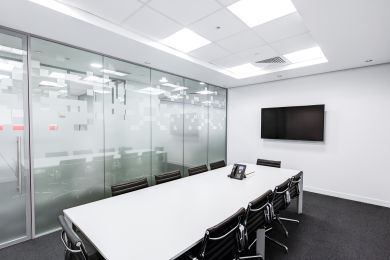Office lighting

Lighting in offices is as or more important as the furniture and decoration chosen for the space. It is proven that lighting can influence our well-being, mood and productivity. However, sometimes the planning of correct and adequate lighting is neglected and left in the background.
Employees often report headaches, tension in the shoulder area or even extreme tiredness. All of these can be symptoms of poor lighting, which in turn can have serious consequences for the health of employees (learn more here).
So, the lighting of our workplace, where we are usually 8 hours a day, deserves special attention when planning it and there are some factors that cannot be ignored.
Natural light
Once again, the process must begin with the assessment of the space's reception of natural light throughout the day.
A space that has the advantage of having a sun exposure that allows abundant natural light to enter during the day will not need such strong or concentrated artificial lighting. On the contrary, a space that has few windows or a northern sun exposure will need to compensate with more artificial lighting.
LED: Savings and quality
If energy efficiency is already an important factor in residential lighting, in an office it becomes essential. Especially in large-scale offices, with several light points, the adoption of efficient light bulbs can translate into savings of hundreds of euros monthly on the electricity bill.
Increasingly, incandescent lamps no longer make sense, and are giving way to LEDs, which have the advantage of having a higher performance and a very low consumption. On the other hand, they also have a longer lifespan, thus avoiding the need to change lamps so often. This factor results in maintenance savings.
In addition to being a slightly more expensive option initially, this investment is guaranteed to pay off in the long run.
Color temperature
Unlike residential lighting, in the business area, it is generally not intended to create welcoming environments, but lighting that promotes productivity.
It is scientifically proven that people work better under cooler lights. Therefore, it is recommended to use a neutral color temperature such as 4000K, a neutral white light tone, which best suits the functions of your employees.
Light intensity
In a functional area such as an office, it is essential to have enough light so that employees can perform their tasks in the best way, without headaches or other problems associated with poor lighting.
The light intensity is defined through Lux in technical terms. This value indicates the amount of light falling on a surface. As a general rule, a minimum of 300 Lux is considered ideal for an office work area and meeting rooms. For more technical areas, such as drawing areas, a minimum of 500 Lux is recommended.
Choosing the right light intensity ensures that your employees work comfortably, without straining their eyes and causing them headaches.
Intelligent regulation systems
Smart lighting control systems are quite interesting and useful, particularly for offices, as they help to save energy and money.
These systems detect changes in daylight and human presence in order to activate the luminaires, which can result in significant savings on the electricity bill at the end of the month. These systems are especially beneficial for offices with many desks and rooms.
Currently, these systems are adapted to mobile devices, such as tablets or smartphones, making their control even more simplified.
Offices are a working environment in which we spend a large percentage of our day. It is therefore essential to plan this space with attention to detail, in order to provide a creative and productive, but also healthy and comfortable environment, so that everyone can perform their duties in the best way.
Do you have an office lighting project and don't know where to start? Send us the quoted plan (preferably in dwg file) and our qualified professionals will take care of the rest!
